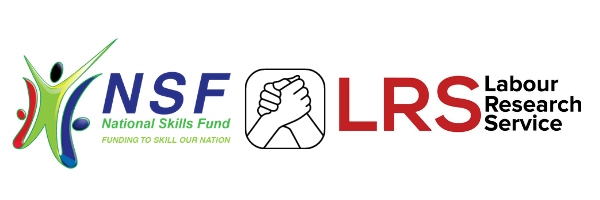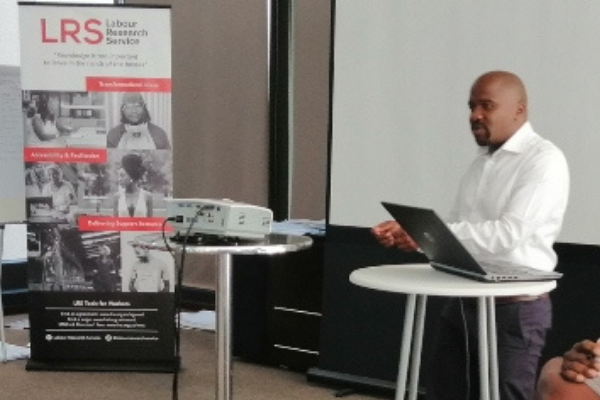In 2019, Labour Research Service (LRS) worked with 29 worker leaders to craft a model Inclusive Collective Bargaining Agreement (ICBA) for our new manual for trade union negotiators in South Africa. Supported by the National Skills Fund (NSF), this work is part of a broader LRS project for promoting informed social dialogue by addressing information and skills asymmetries in collective bargaining in South Africa. The participants involved in our peer learning process acknowledged that trade union organising and bargaining processes are changing, and provided rich input that’ll assist organisations to have more inclusive collective bargaining agendas.
The worker leaders participating in the process wanted to know how they can be more effective at the Commission for Conciliation, Mediation & Arbitration (CCMA), the dispute resolution body established in terms of the Labour Relations Act. We invited Nhlanhla Ndaba (pictured), a commissioner at CCMA’s office in Johannesburg to address them. Below is an extract of Mr Ndaba’s presentation.
Welcome to CCMA
The CCMA is an independent institution that helps parties to resolve labour disputes. Independent means we don’t work at the behest of any party. We advocate for fairness in dispute resolution between employees and employers.
Let’s dig into the mandatory functions of CCMA. For this purpose, I will focus on how the commission resolves, conciliates and mediates disputes.
The first task for any person wanting to open a case at the CCMA is to provide a detailed account of the dispute. Ensure the information you complete on the form is thorough because it helps to establish if the CMMA has the authority to deal with the specific dispute.
I will expound on the core functions of the CCMA using the example of unfair dismissal, which is a common dispute issue. When you lodge an unfair dismissal dispute, it means a dismissal occurred. There are two questions you must answer when you claim your dismissal is unfair: Why were you dismissed? How were you dismissed? The answers you provide will determine the next step to take.
Let’s look at why you were dismissed. The law lists up to four reasons for a dismissal, but I’ll focus on the three most common reasons:
- In a misconduct case, you’ll tell us that you’ve done something wrong, for example, you were late or you absconded work. Theft can be another reason here, but there’s a separate procedure to follow.
- If you say you were dismissed for non-performance, or in other words being unable to do what is expected of you, the issue is classified as performance-related.
- If the dismissal happens because a company is shutting down because it doesn’t have money or it lost a major contract then we know the issue is operational-related, a retrenchment.
You must file the case within 30 days of dismissal. The CCMA doesn’t have the authority to help you after the 30 days lapse unless you apply for condonation. A condonation is filled out on a CCMA-issued pro forma affidavit, which is basically a notarised form. On this form, you could state, for example, “I came to the CCMA late not because of my own doing… so please accept my case.” Tell us why you were late in lodging the dispute and the potential of winning the case. Articulate how you’ll be prejudiced if the case doesn’t go ahead. Note that the employer has the right to oppose a condonation application.
In a nutshell, the CCMA considers the following when deciding whether or not to grant a condonation:
- How late was the referral?
- What is the reason for the lateness?
- What are the prospects of success on the merits?
- Is there any prejudice to both parties if the matter doesn’t go ahead?
Now, let’s assume the dispute is referred successfully. The CCMA uses a form called 711 to refer disputes, which you can now proceed to complete.
In South Africa, we don’t have ambush law. This means when you open a case against someone you must tell them. The CCMA won’t accept the completed form 711 unless you can prove that the employer was served. Don’t ignore this step and give ammunition to devious employers who like to stall dispute processes. You can serve the employer electronically, through the post office, a courier or by hand. Ensure the employer has signed the notice, and with this proof, we can proceed to open a case. The law demands that you must appear before a commissioner within 30 days of receiving your unfair dismissal case number.
The CCMA has several mandatory functions concerning a referred dispute. Let’s continue with the example of unfair dismissal example to explain the four processes that can be used to assist parties to resolve disputes.
Pre-conciliation process
Pre-conciliation is a voluntary process through which parties are assisted to resolve disputes telephonically by a CCMA pre-conciliator. Pre-conciliation process works best for workers in vulnerable employment who might find it difficult appearing at the CCMA office in person. Domestic workers, farmworkers and security guards are some examples of the kind of employees targeted by this process. Often the worker in a pre-con process has a long relationship with the employer. Consider a domestic worker who’s perhaps been with one family for decades, raising children to adulthood and thus creating a bond. Our pre-conciliators would phone the parties involved and remind them of the long working relationship, with a view of facilitating an amicable solution to facilitate either a harmonious working environment going forward or a fair separation that is agreeable to both parties.
Conciliation process
In the conciliation process, the CCMA provides a date for a face-to-face hearing of the matter. Conciliation process is similar to pre-conciliation, except you’d appear before the commissioner assisting you. The process is voluntary and also tries to facilitate an amicable solution. Remember you can’t be forced to accept a settlement you don’t want. Commissioners aren’t allowed to tell you during the conciliation process that you won’t win the case. And if a commissioner tells you that your case is doomed, you have the right to insist on a fair process. We can’t also advise or coerce you to take an employer’s offer because it defeats the purpose of the process, which is to help parties find a fair and agreeable solution. As commissioners, we wouldn’t know who’s telling the truth based on the presented evidence because we don’t listen to evidence at this stage. The goal is to advise you on the next steps of action. Employers use intimidation and other tactics to pressure employees to take their offer. Such tactics include hiring lawyers and other relevant professionals. As a worker representative, be firm and have confidence in the case and the evidence presented.
Arbitration process
The matter goes to arbitration if the dispute isn’t resolved at conciliation. Arbitration process suits parties that can’t find a solution on their own. The commissioner will decide if the dismissal is unfair, but only based on the presented evidence. To illustrate further, imagine that an employer of a domestic worker claims she lost valuables in the house and only the two of them were in the house. Taken at face value one might assume the valuables existed and that the domestic worker is indeed guilty. But, the employer must provide evidence that the valuables were in the house in the first place. Some people threaten they can prove things but can’t deliver during the arbitration process, which relies solely on evidence. The award (the decision made by the commissioner arbitrating the matter) is final and binding to both parties and can only be reviewed by a labour court, except in cases of sexual harassment. The labour court only investigates the conduct of the commissioner and not the facts of the matter.
Con-arb process
Con-arb stands for ‘conciliation’ and ‘arbitration’ and both processes must happen on the same day. Think of it as a ‘short-cut’ process of resolving labour disputes that’s allowed by the LRA. The process of con-arb is compulsory when the dispute concerns the following: the dismissal of an employee for any reason relating to probation; any unfair labour practice relating to probation. Note that con-arb is possible in other kinds of disputes, provided neither party objects. It’s essential to understand what con-arb means in your context and to begin preparing immediately because you’ll seldom get more than two weeks advance notice of this process. The CCMA performs the above processes in your interest. Therefore, familiarise yourself with the functions and responsibilities of the commission. You can find useful resources online, including the complete list of the commission’s discretionary functions, which include providing training and guide to labour legislation, supervising ballots for trade unions and supporting workers who’re covered by the Basic Conditions of Employment Act (BCEA).
The following disputes cannot be referred to the CCMA:
- where an independent contractor is involved
- where the case doesn’t deal with an issue in the LRA or Employment Equity Act. BCEA issues may be linked to unfair dismissal disputes and unfair retrenchment disputes
- where a bargaining council or statutory council exists for that sector
- where a private agreement exists for resolving disputes
Specialised training for CCMA commissioners
CCMA commissioners are trained at various universities in South Africa. A person can also apply directly to the commission, which then provides inhouse training. I am pleased to hear the LRS peer learning process deliberated on organising and bargaining strategies for workers in precarious forms of employment. The course work for the training of CCMA commissioners has a strong social justice module that covers issues such as discrimination and sexual harassment at the workplace.
A CCMA commissioner must treat everyone with equal rights under the law. Commissioners are trained to not let perceptions cloud their judgements and work, and can recuse themselves from matters they know will cause them to be prejudiced. I am speaking to the stipulated competencies and character of a CCMA commissioner, but we are human beings and we make mistakes. Not all commissioners are sensitive to social justice issues and I know colleagues who’ve lost their jobs for it.
There’s a process for addressing any issue you might have with a specific commissioner. You can contact a senior commissioner in your region or phone our call centre to start the complaint process.
Migrant workers in South Africa
All workers have rights and are protected by labour laws in South Africa. Thus, the CCMA helps and will continue to help all workers who approach the commission, including employed undocumented migrants, but they are required to show some form of identification and provide of the employer’s details. Our statistics show a lot of migrant workers approach the CCMA to fight for their workplace rights. It is a criminal offence to employ an undocumented migrant. Any person who employs an undocumented person qualifies them for protection under the labour laws of South Africa.
Procedures for dismissing ‘casual workers’
The term ‘casual’ doesn’t appear in the BCEA and LRA.
When an employer speaks about ‘casual’, ask what they mean. In my experience, the definition of the terms ‘casual work’ and ‘casual worker’ varies from company to company. The only commonality is some employers think a ‘casual worker’ has no rights and can, therefore, be fired at a whim. Do not be fooled. We only have employees who have the right not to be treated unfairly.
Every employer has the right or authority to dismiss an employee. This right isn’t regulated by the law. Every employee (any person who works for another and who receives, or is entitled to receive, any payment for that work whether in money or in kind) has the right not to be unfairly dismissed. This right is regulated by law, and the dismissal must be fair.
There must be a reason and procedure for dismissing a worker otherwise the dismissal is termed unfair.
Fixed-term contracts
A note on fixed-term contracts in the context of part-time work. A fixed-term contract is defined as the name implies – a contract which runs from one specified date to another specified date.
If a company has a five-year contract to provide services to another entity, its workers’ contracts will likely be tied to the duration of the contract, by a fixed-term contract that’s related to a third party.
Be vigilant when scrutinising fixed-term contracts. If a contract is quiet about when it lapses and under what conditions, consider it a fixed-term contract. In other words, an employee can’t be dismissed if the starting and ending conditions weren’t specified. The only option for an employer wanting to layoff workers in such a case is offering retrenchment and with full severance pay. However, the 2014 amendments to the law provided that if an employee is on a fixed-term contract for two years and above they are entitled to severance pay.








